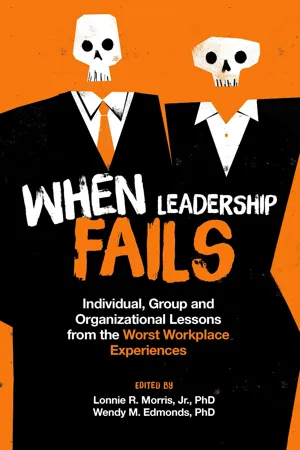
When Leadership Fails
Individual, Group and Organizational Lessons from the Worst Workplace Experiences
- 240 pages
- English
- ePUB (mobile friendly)
- Available on iOS & Android
When Leadership Fails
Individual, Group and Organizational Lessons from the Worst Workplace Experiences
About This Book
When Leadership Fails is a multidisciplinary resource for researchers and practitioners. As a curated selection of unique, scholar-practitioner reflections from around the world, this collection highlights both the universal impact of leaders behaving badly and the communal triumph that emerges from deconstructing these experiences in aggregate. In addition to expert insight into these leadership and organizational challenges, readers benefit from the application of empirical and theoretical research for analysis and interpretation. Readers will gain a deeper understanding of the individual, group and organizational implications of negative leadership encounters in the workplace. Readers will find value in the immediate application of these lessons to their own careers and organizations.
Frequently asked questions
Information
Chapter 1
Monsters, Inc.: Toxic Leadership and Engagement
Abstract
Introduction
- How does a manager’s behavior sustain or hinder employees’ willingness to bring their whole selves to work?
- What is the impact of managers’ behaviors on employees and their engagement?
Background: Toxic Leadership and Engagement
Toxic Leadership
Employee Engagement
- Interpersonal relationships: Employees feel safer when they can be vulnerable at work and when workplace interpersonal relationships are positive (Kahn, 1990).
- Intergroup dynamics: Healthy groups provide protection (and thus, feelings of safety) to its members, increasing morale and rapport (Salanova et al., 2005).
- Management: Employees feel safer when managers are supportive and empowering. Engaging managers accept occasional failure without negative consequences (Kahn, 1990). A recent meta-analysis on safety confirmed the relationships between positive interactions with the manager and the employee’s feelings of safety (Frazier et al., 2017)
- Organizational norms: Employees appreciate clarity, predictability, and stability in organizational rules and norms (Kahn, 1990).
Table of contents
- Cover
- Title
- Introduction: Acknowledging, Deconstructing and Processing When Leadership Fails
- Chapter 1. Monsters, Inc.: Toxic Leadership and Engagement
- Chapter 2. Investing the Time to Lead Well
- Chapter 3. Front Porch Organizations, Back Door Employees: How Mentoring Mishaps Potentially Derail Next Generation Leaders
- Chapter 4. Toxic Followership: Leader Deception and Breach of Trust
- Chapter 5. Death by Authoritative Leadership and Micro‐management
- Chapter 6. Campus in Crisis: Leadership Lessons Learned
- Chapter 7. Ethics, Leadership and the Dreaded Performance Appraisal
- Chapter 8. Autocratic Leadership among Managers and Its Impact on Salespersons Behavior in India’s Pharmaceutical Industry
- Chapter 9. Leadership Failure in a Hostile Environment: The Importance of Leading Oneself
- Chapter 10. Toxic Leadership: A Quick Erosion of Psychological Safety
- Chapter 11. A Wolf in Sheep’s Clothing: How a Narcissistic Leader Decimated a Faith-Based Nonprofit
- Chapter 12. When Founder’s Syndrome Is Used for Personal Gain
- Chapter 13. How to Destroy a Research & Development Group without Really Trying
- Chapter 14. When Leading the Team Goes Wrong
- Chapter 15. No Rest in the Restroom: Servant Leadership and Conflict in Products & Marketing
- Chapter 16. The Demise of a Company: An Insider’s Personal and Scholarly Reflection
- Chapter 17. Incompetent Authoritarian Replaces a Servant Leader
- Appendix: Interview Protocol – Toxic Leadership Study
- Index